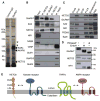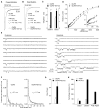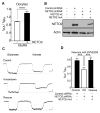A transmembrane accessory subunit that modulates kainate-type glutamate receptors
- PMID: 19217376
- PMCID: PMC2803770
- DOI: 10.1016/j.neuron.2008.12.014
A transmembrane accessory subunit that modulates kainate-type glutamate receptors
Abstract
Glutamate receptors play major roles in excitatory transmission in the vertebrate brain. Among ionotropic glutamate receptors (AMPA, kainate, NMDA), AMPA receptors mediate fast synaptic transmission and require TARP auxiliary subunits. NMDA receptors and kainate receptors play roles in synaptic transmission, but it remains uncertain whether these ionotropic glutamate receptors also have essential subunits. Using a proteomic screen, we have identified NETO2, a brain-specific protein of unknown function, as an interactor with kainate-type glutamate receptors. NETO2 modulates the channel properties of recombinant and native kainate receptors without affecting trafficking of the receptors and also modulates kainate-receptor-mediated mEPSCs. Furthermore, we found that kainate receptors regulate the surface expression of NETO2 and that NETO2 protein levels and surface expression are decreased in mice lacking the kainate receptor GluR6. The results show that NETO2 is a kainate receptor subunit with significant effects on glutamate signaling mechanisms in brain.
Figures






References
-
- Armstrong N, Gouaux E. Mechanisms for activation and antagonism of an AMPA-sensitive glutamate receptor: crystal structures of the GluR2 ligand binding core. Neuron. 2000;28:165–181. - PubMed
-
- Bortolotto ZA, Clarke VR, Delany CM, Parry MC, Smolders I, Vignes M, Ho KH, Miu P, Brinton BT, Fantaske R, et al. Kainate receptors are involved in synaptic plasticity. Nature. 1999;402:297–301. - PubMed
Publication types
MeSH terms
Substances
Grants and funding
LinkOut - more resources
Full Text Sources
Other Literature Sources
Molecular Biology Databases

